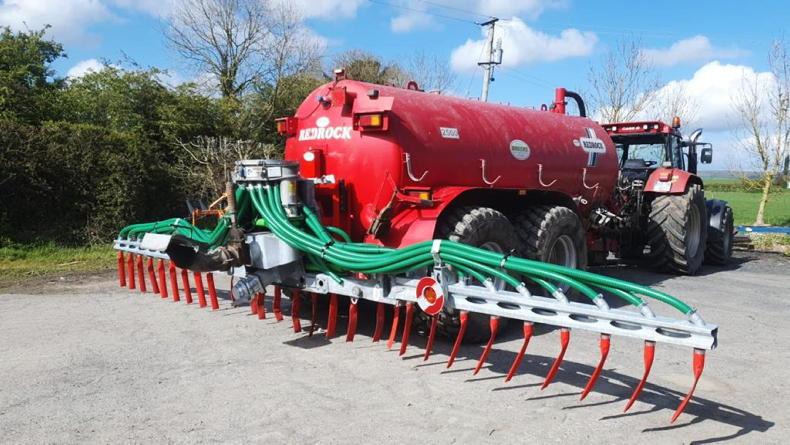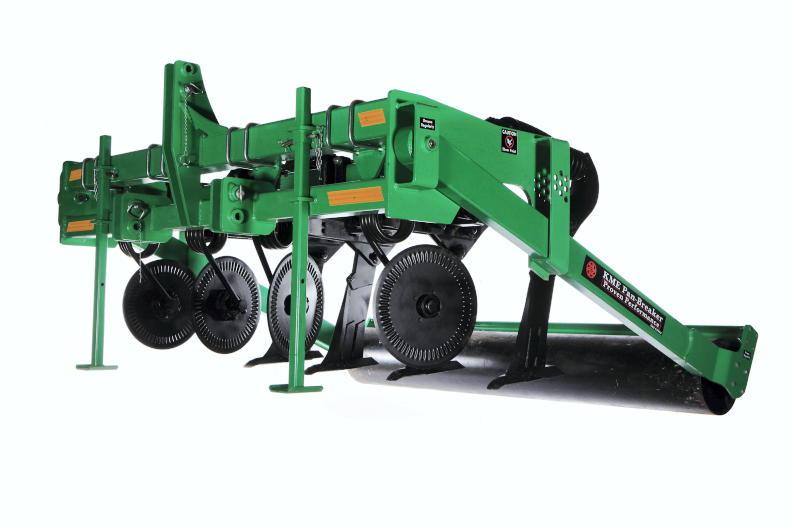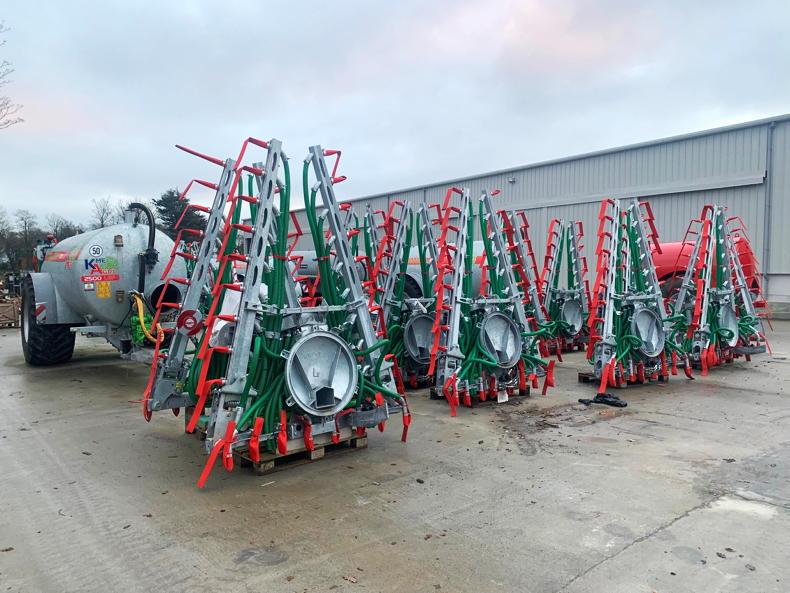Growing up on the family farm near Listowel, Co Kerry, Fergus O’Keeffe was quick to find a passion for mechanics and problem-solving.
During school, much of his free time was spent alongside his uncle Brendan who worked as a mobile fitter-fabricator.
This inspired Fergus to take up an apprenticeship as a fitter-fabricator with a local business. Shortly after qualifying, he made the brave move of starting his own business.
Background
Up until building his own workshop in 1997, Fergus had been providing mobile welding and fabrication services to local farmers and contractors. This 47ft x 35ft workshop was the cradle of Kerry Mechanical Engineering (KME). During the quieter winter starting out, Fergus decided to manufacture his own silage trailers.
“Having been in many contractors’ yards, I’d seen the good and the bad of most trailers.
“Naïvely, I said I’d give it a go. I built a strong trailer equipped with commercial running gear and a steering axle. After building a handful of trailers I soon realised that there wasn’t an appetite among contractors yet for this sort of specification. I lost deals to other manufacturers purely down to price even though the trailers weren’t like for like in terms of specification,” he explained.

A 7.5m KME dribble bar retro fitted to a a 2500 gallon Redrock tanker.
At this point Fergus employed six people and began taking on a lot of factory maintenance and shutdown work for companies like Irish Cement.
Liebherr
Twelve years ago he was offered a contract with Liebherr to design and build bespoke platforms for its container cranes (built in Killarney). These are the large cranes you see working in ports across the world handling containers. Today this contract, alongside structural steelwork for large projects such as Intel, account for 60% of the KME business.
In total, KME employs 60 people, 40 of whom are dedicated to the industrial fabrication side of the business.
Subsoilers
“Ten years ago, we had a guy in subsoiling land at home. It wasn’t a success, in fact it left the land worse off. But to me, I felt that the machine used was designed for tillage land and not grassland. Liking the concept, I built a machine which I felt suited grassland. It was completely mechanical in the sense that each leg had its own spring break-back protection instead of hydraulic reset. Depth could be set via the rear roller. The difference between the two machines was night and day.

The KME Pan-breaker.
“They were quite a slow burner at the time. Similarly, some farmers had a bad previous experience with the wrong machines and therefore moved away from subsoiling. It seems that only in more recent years farmers are placing more of an importance on soil health and soil structure.”
LESS equipment
Two years ago KME decided to branch into the agricultural side of the market and offer its own retrofit and umbilical dribble bar range.
“We had a number of local farmers and contractors come to us with various makes and models of LESS systems needing repair – this got me thinking. The common issues were macerators and cracked rear doors on slurry tankers.

A 2000 gallon KME slurry tanker and 7.5m dribble bar.
“As many systems as there were on the market at the time, there was still an opening for a simple, well-built unit that worked, especially in terms of a macerator.
“My business partner Con Daly came on board to progress the agri side of things. Our first product was the KME dribble bar which comprises three working widths: 7.5m (28 outlets), 9.6m (36 outlets) and 12m (twin macerator). Everything is built in house using proven components. Our systems are both rear door- and chassis-mounted for additional strength. We have built in a safety system that once the macerator is open, it cannot be engaged nor can the rear lollipop open. A diverter valve returns oil flow to the tractor. As standard every system is also fitted with break-back protection.
In-house macerator
“We went against the grain and designed a horizontal macerator completely in the interest of access. We found from our research that there was no real benefit to a vertical macerator. Open two latches and lift the hinged lid and you’re in. Inside is a patented breather plate protected by a shear plate, instead of vent plugs seen on other units. A turbine-like blade carrier which has six blades runs on the shear plate to cut fibrous material.

KME says that the advantage of its macerator is that it is horizontally mounted for access purposes.
The only maintenance involved is checking blade condition and keeping the bolt that holds the blade carrier assembly in place torqued to 25Nm. This keeps the blades running flush with the shear plate as wear occurs.
Markets and future plans
“In our first year we sold 15 machines and appointed two dealers. To date, we have 20 dealers in Ireland and two in England. Brexit and the COVID-imposed implications have left it very hard to get machines into the UK.
“What was positive early on was sales in areas led to additional sales nearby based on customer results. Now nearing the end of our second year, we have in the region of 300 dribble bars working between here and the UK. Obviously, TAMS grant aid continues to drive the market but the simplicity of our machines give us the edge, I feel.

Kerry Mechanical Engineering, Listowel, Co Kerry.
“Over lockdown we decided to build a run of slurry tankers ranging from 2,000-2,500 gallons in size. We cut no corners, the barrels were all built using 6mm steel and fully galvanised. We fitted Granning axles and Battioni vacuum pumps.”
In terms of future plans for the agri side of things, Fergus remained tight-lipped. However, he did say that once the spreading ban lifts the company will enter the prototype stages with a new machine to aid umbilical spreading. Aside from that, KME will launch a 7.5m and 9.6m trailing shoe range in 2022.
Threats/opportunities
Fergus is confident that there is a healthy outlook within the Irish engineering sector, especially for those willing to adapt and diversify. “The key to survival in the current climate is to become as lean and as efficient as possible in every aspect of the business from design through to manufacturing processes and labour.

Fergus O'Keeffe, KME managing director.
“Eight weeks ago we completed a €3m investment which includes a 30,000sq ft workshop which will house a new flatbed laser and tube laser cutter, the laser being only one of its kind in the south of the country. It’s this type of equipment and automation that allows us to increase efficiency and productivity. For example, there’s an assembly for the dribble bars that previously took 45 minutes to manufacture. With the new laser, five minutes will do the same job.
“Now that we have the new laser cutting equipment, we are offering a contract cutting service to other manufacturers. This way we can run the machines on shifts to maximise their use.
“The obvious threat which has been around for the majority of 2021 is the cost of steel among other materials. That said, the past few weeks have been the first in months that we haven’t received an email from our steel supplier stating a price rise with immediate effect. So here’s hoping that costs stabilise now heading into 2022. Energy prices too are a concern, so too is supply looking into he future.”
Profile
Business: Kerry Mechanical Engineering (KME).
Managing director: Fergus O’Keeffe.
Employees: 60.
Address: Listowel, Co Kerry.
Growing up on the family farm near Listowel, Co Kerry, Fergus O’Keeffe was quick to find a passion for mechanics and problem-solving.
During school, much of his free time was spent alongside his uncle Brendan who worked as a mobile fitter-fabricator.
This inspired Fergus to take up an apprenticeship as a fitter-fabricator with a local business. Shortly after qualifying, he made the brave move of starting his own business.
Background
Up until building his own workshop in 1997, Fergus had been providing mobile welding and fabrication services to local farmers and contractors. This 47ft x 35ft workshop was the cradle of Kerry Mechanical Engineering (KME). During the quieter winter starting out, Fergus decided to manufacture his own silage trailers.
“Having been in many contractors’ yards, I’d seen the good and the bad of most trailers.
“Naïvely, I said I’d give it a go. I built a strong trailer equipped with commercial running gear and a steering axle. After building a handful of trailers I soon realised that there wasn’t an appetite among contractors yet for this sort of specification. I lost deals to other manufacturers purely down to price even though the trailers weren’t like for like in terms of specification,” he explained.

A 7.5m KME dribble bar retro fitted to a a 2500 gallon Redrock tanker.
At this point Fergus employed six people and began taking on a lot of factory maintenance and shutdown work for companies like Irish Cement.
Liebherr
Twelve years ago he was offered a contract with Liebherr to design and build bespoke platforms for its container cranes (built in Killarney). These are the large cranes you see working in ports across the world handling containers. Today this contract, alongside structural steelwork for large projects such as Intel, account for 60% of the KME business.
In total, KME employs 60 people, 40 of whom are dedicated to the industrial fabrication side of the business.
Subsoilers
“Ten years ago, we had a guy in subsoiling land at home. It wasn’t a success, in fact it left the land worse off. But to me, I felt that the machine used was designed for tillage land and not grassland. Liking the concept, I built a machine which I felt suited grassland. It was completely mechanical in the sense that each leg had its own spring break-back protection instead of hydraulic reset. Depth could be set via the rear roller. The difference between the two machines was night and day.

The KME Pan-breaker.
“They were quite a slow burner at the time. Similarly, some farmers had a bad previous experience with the wrong machines and therefore moved away from subsoiling. It seems that only in more recent years farmers are placing more of an importance on soil health and soil structure.”
LESS equipment
Two years ago KME decided to branch into the agricultural side of the market and offer its own retrofit and umbilical dribble bar range.
“We had a number of local farmers and contractors come to us with various makes and models of LESS systems needing repair – this got me thinking. The common issues were macerators and cracked rear doors on slurry tankers.

A 2000 gallon KME slurry tanker and 7.5m dribble bar.
“As many systems as there were on the market at the time, there was still an opening for a simple, well-built unit that worked, especially in terms of a macerator.
“My business partner Con Daly came on board to progress the agri side of things. Our first product was the KME dribble bar which comprises three working widths: 7.5m (28 outlets), 9.6m (36 outlets) and 12m (twin macerator). Everything is built in house using proven components. Our systems are both rear door- and chassis-mounted for additional strength. We have built in a safety system that once the macerator is open, it cannot be engaged nor can the rear lollipop open. A diverter valve returns oil flow to the tractor. As standard every system is also fitted with break-back protection.
In-house macerator
“We went against the grain and designed a horizontal macerator completely in the interest of access. We found from our research that there was no real benefit to a vertical macerator. Open two latches and lift the hinged lid and you’re in. Inside is a patented breather plate protected by a shear plate, instead of vent plugs seen on other units. A turbine-like blade carrier which has six blades runs on the shear plate to cut fibrous material.

KME says that the advantage of its macerator is that it is horizontally mounted for access purposes.
The only maintenance involved is checking blade condition and keeping the bolt that holds the blade carrier assembly in place torqued to 25Nm. This keeps the blades running flush with the shear plate as wear occurs.
Markets and future plans
“In our first year we sold 15 machines and appointed two dealers. To date, we have 20 dealers in Ireland and two in England. Brexit and the COVID-imposed implications have left it very hard to get machines into the UK.
“What was positive early on was sales in areas led to additional sales nearby based on customer results. Now nearing the end of our second year, we have in the region of 300 dribble bars working between here and the UK. Obviously, TAMS grant aid continues to drive the market but the simplicity of our machines give us the edge, I feel.

Kerry Mechanical Engineering, Listowel, Co Kerry.
“Over lockdown we decided to build a run of slurry tankers ranging from 2,000-2,500 gallons in size. We cut no corners, the barrels were all built using 6mm steel and fully galvanised. We fitted Granning axles and Battioni vacuum pumps.”
In terms of future plans for the agri side of things, Fergus remained tight-lipped. However, he did say that once the spreading ban lifts the company will enter the prototype stages with a new machine to aid umbilical spreading. Aside from that, KME will launch a 7.5m and 9.6m trailing shoe range in 2022.
Threats/opportunities
Fergus is confident that there is a healthy outlook within the Irish engineering sector, especially for those willing to adapt and diversify. “The key to survival in the current climate is to become as lean and as efficient as possible in every aspect of the business from design through to manufacturing processes and labour.

Fergus O'Keeffe, KME managing director.
“Eight weeks ago we completed a €3m investment which includes a 30,000sq ft workshop which will house a new flatbed laser and tube laser cutter, the laser being only one of its kind in the south of the country. It’s this type of equipment and automation that allows us to increase efficiency and productivity. For example, there’s an assembly for the dribble bars that previously took 45 minutes to manufacture. With the new laser, five minutes will do the same job.
“Now that we have the new laser cutting equipment, we are offering a contract cutting service to other manufacturers. This way we can run the machines on shifts to maximise their use.
“The obvious threat which has been around for the majority of 2021 is the cost of steel among other materials. That said, the past few weeks have been the first in months that we haven’t received an email from our steel supplier stating a price rise with immediate effect. So here’s hoping that costs stabilise now heading into 2022. Energy prices too are a concern, so too is supply looking into he future.”
Profile
Business: Kerry Mechanical Engineering (KME).
Managing director: Fergus O’Keeffe.
Employees: 60.
Address: Listowel, Co Kerry.












 This is a subscriber-only article
This is a subscriber-only article










SHARING OPTIONS: